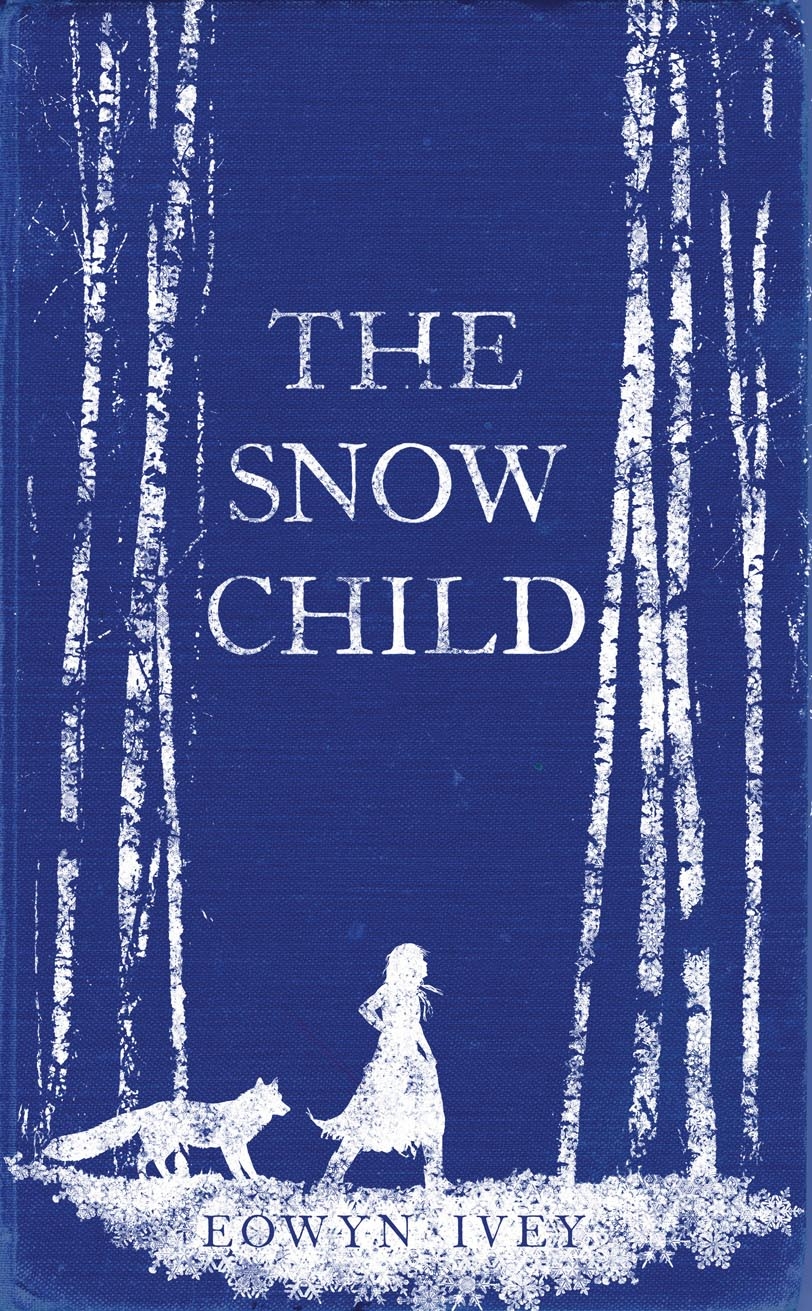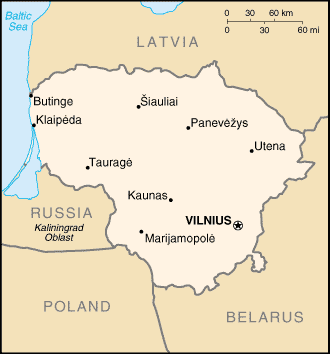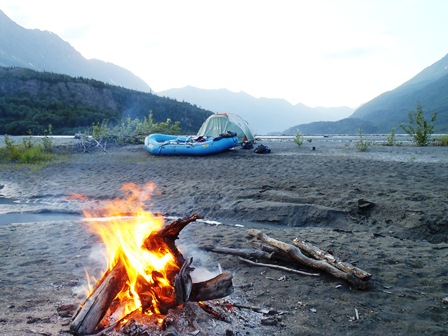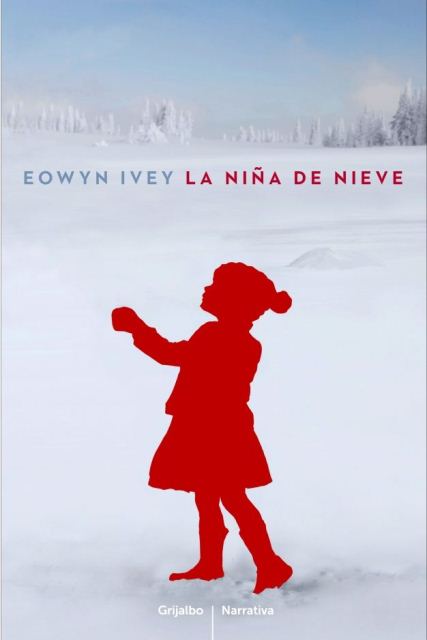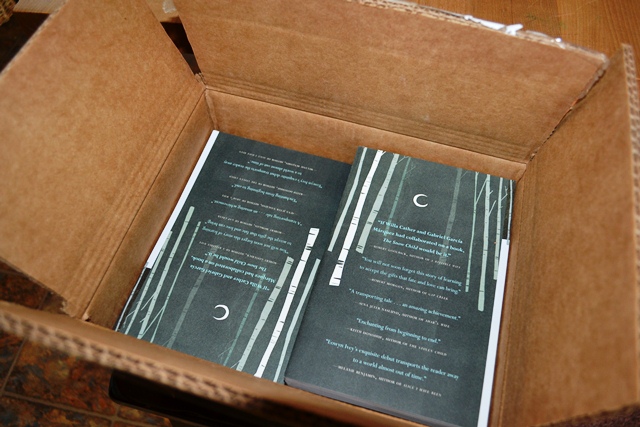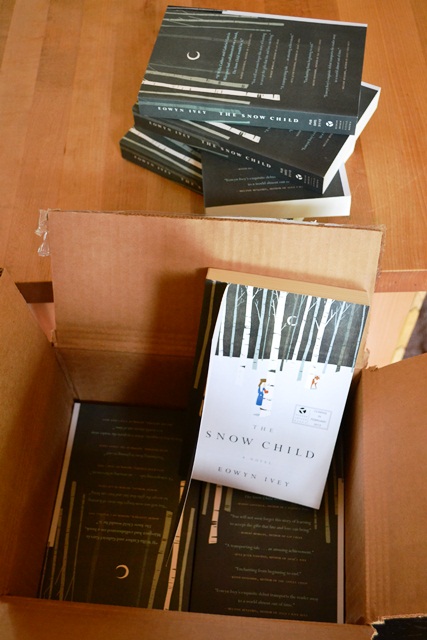Copper River to London to Vilnius
Dear worldly reader,

Fireweed blooms with Miles Glacier icebergs in the background. This was near our final camping site.
One of the side-effects of all this book excitement is that I have become an obsessive email checker. As much as I try, I cannot walk by my laptop without taking a quick peek.
To be honest, it was a relief to be out of internet/phone range while I floated the Copper River. As much as I enjoy the roller-coaster ride of publishing, there is a purity that comes with any time I spend in the wilderness. Life is reduced to necessity — food, clothing, shelter, safety. You don’t worry about Twitter or Facebook or online reviews. You worry about having enough clean water to drink and staying warm enough, finding a place to unroll your sleeping bag and not shooting a hole in the raft if you have to scare off a bear in the night.
But as soon as I returned to civilization, after I had hugged my family and taken a shower, well … I got online.
“See?” I told my husband with a touch of panic and excitement in my voice. “See? THIS is why I have to check my email.”
One of the first emails I came across was from my UK editor. She was sending my first glimpse of their beautiful cover for my book.
Then the roller coaster nose dived. There was an email from the publisher of Little, Brown. My fabulous editor, Andrea Walker, had announced that she would be leaving to become senior fiction editor at Penguin Press. This is the editor who acquired my book, who worked with me the past year to prepare it for publication, who had the vision for the cover. We had come to enjoy each other both as colleagues and friends. I was sad, but also excited for her. And, ultimately, I was calmed by the knowledge that my book continues to be in the hands of the amazing Reagan Arthur and everyone else at Little, Brown & Co.
Then, scanning through the inbox, my eye caught on a chain of messages titled “Lithuania.” The emails were between my agent and Tracy, who handles foreign rights at Little, Brown.
“Lithuania? Lithuania!”
Yep. While I was floating down the river, the UK settled on a cover, my editor announced her departure, and The Snow Child sold to Metodika, a publisher in Vilnius, the capital of Lithuania.
“See,” I said to Sam, just in case he hadn’t heard the first few times. “I’m telling you. That’s why I have to check my email ALL the time.”
Cheers!
Eowyn
Floating through a powerful world
Dear persevering reader,
When my husband Sam and I set out on the Copper River last week in a 14-foot raft, I knew we would travel through wild, beautiful places. It was an opportunity for me to get to know a landscape that I have been walking through in my imagination for months. What I didn’t yet comprehend was the powerful nature of this river.
Earlier this year, I was awarded a grant from the Rasmuson Foundation to enable me to float the river to research my next novel. We went armed with a camera, a write-in-the-rain journal, field identification books, maps, freeze-dried food, the report of an 1885 expedition up this same river, chest waders, rain gear, and a rifle for bear protection.
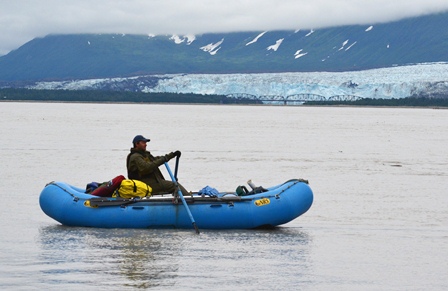 We launched the raft with the help of a friend near Chitina, Alaska, and spent the next week floating to Cordova, toward the ocean. Every second, the Copper discharges more than 400,000 gallons of icy, silty water. In that deep gray beneath our raft, thousands of sockeye salmon swam toward their spawning grounds.
We launched the raft with the help of a friend near Chitina, Alaska, and spent the next week floating to Cordova, toward the ocean. Every second, the Copper discharges more than 400,000 gallons of icy, silty water. In that deep gray beneath our raft, thousands of sockeye salmon swam toward their spawning grounds.
 About half-way through the 80-mile trip, seals began to appear. They would surface and bob near the raft, their eyes wide and watchful. Occasionally one would have a salmon in its mouth. One morning, they awoke us from our tent with their playful splashing in the river.
About half-way through the 80-mile trip, seals began to appear. They would surface and bob near the raft, their eyes wide and watchful. Occasionally one would have a salmon in its mouth. One morning, they awoke us from our tent with their playful splashing in the river.
Wherever we pulled out on the river bank, we saw sign of bears. Tracks in the sand, piles of scat, bloody salmon remains in the bushes. We tried to camp where there was the least amount of bear traffic, but it seemed inevitable that we would eventually see one. Not far from Haley Creek, there she was — a female brown bear with two cubs. She walked along the beach, stopping occasionally to eye us and wait for her cubs. I could have watched her all day from that safe distance, but the river swept us away.
 We encountered every kind of weather — sunshine that scorched our faces, winds that kicked up sand storms and white caps on the river, drizzly rain. Sam rowed us around giant, swirling eddies, through Abercrombie Rapids, and between house-sized icebergs from Miles Glacier. We floated through towering canyons, past waterfalls and sand
We encountered every kind of weather — sunshine that scorched our faces, winds that kicked up sand storms and white caps on the river, drizzly rain. Sam rowed us around giant, swirling eddies, through Abercrombie Rapids, and between house-sized icebergs from Miles Glacier. We floated through towering canyons, past waterfalls and sand 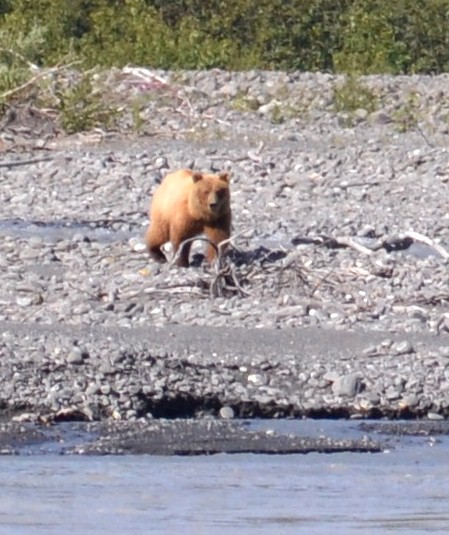 dunes, ancient glaciers, and the decaying remnants of a railroad that brought copper out of the mountains 100 years ago. In the distance, we heard glaciers calving and it sounded like canons being fired.
dunes, ancient glaciers, and the decaying remnants of a railroad that brought copper out of the mountains 100 years ago. In the distance, we heard glaciers calving and it sounded like canons being fired.
All the while I had the growing realization that this place was relentless, that no matter feats of engineering or little rubber rafts, this river was rushing, cold and silty, to the ocean just as it has for thousands of years.
At one point, Sam and I watched the wind obliterate paw prints across a sand bar.
“Tracks don’t last long around here,” he said.
Cheers!
Eowyn
Once upon a time …
Once upon a time there was a little girl who met a wolf in the woods …
or, there was an old man and old woman who more than anything wanted a child of their own …
or a boy who caught a fish that spoke to him …
or two children with an evil step-mother …
or a bag of magic beans …
Both THE SNOW CHILD and my novel-in-progress have a framework built of fairy tales. I’ve always been fascinated by these deceptively simple stories, and the art, novels, and movies they inspire. A friend of mine, Annie Aube, turns fairy tales into subversive, sometimes disturbing embroidery art. One of my favorite films, PAN’S LABYRINTH, is a Spanish civil war fairy tale. One of my favorite books is THE LIFE OF PI. In each of these, there is the question of what is real and what is fairy tale, and of how and why we translate experience into fairy tale. In the case of Annie Aube’s art, the question is turned upside down, and the stories are viewed through a new lens.
Earlier this week, the author Neil Gaiman recommended through Twitter this incredible New York Times article on fairy tales. It is written by Valerie Gribben, a medical student who finds the connections between her favorite childhood book of Grimm’s fairy tales and what she sees at the hospital each day.
“Fairy tales are, at their core, heightened portrayals of human nature, revealing, as the glare of injury and illness does, the underbelly of mankind,” she writes.
At the same time, I stumbled upon this quote online —
“Fairy tales are experienced by their hearers and readers, not as realistic, but as symbolic poetry.” — Max Luthi
Between these two interpretations, I feel like I’m coming closer to understanding why I am drawn to fairy tales. They speak a kind of truth — one of human longing and suffering — but do it through poetic, symbolic language that enables us to see beauty and goodness even as we look at the darkness.
Hope your day is happily ever after,
Eowyn
And the winners are …
When I announced last week that I would draw names to give away a few advance reader copies of my novel, I anticipated only fun and good cheer. Instead I feel humbled by the response, and a bit lousy because I can’t give each and every one of you a copy. What kind of author says no to someone who wants to read her book?
I decided to draw names the old-fashioned way (random.org proved too intimidating.) Last night my daughter and I wrote all the names on identical size and color pieces of paper, folded them in half, and put them in a black hat. I then held the hat well above her head, and my daughter drew the names.
In hopes of garnering some sympathy for my difficult plight, I first want to list some of the people who did NOT win: a few of my favorite customers at Fireside Books did NOT win. New friends. Old friends. Readers who came to me because another author said they should. My grandmother’s best friend. The members of my book club, my very own Betties — not one of them won. My flesh-and-blood relatives. My dear new Italian friend — the one who promised me her first unborn child and, more importantly a ride on her Vespa through Rome for Pete’s sake — did NOT win an ARC. And my favorite librarian, the one who orders research books for me from other libraries — she did NOT win an ARC. The gods of literacy are surely going to smite me down.
But, all that said, I am thrilled to get to announce the five people whose names did get pulled out of the hat. The list includes a couple of old friends and a few people I haven’t had the privilege of meeting yet. You are among my very first readers, and I am honored that you want a copy. I hope you enjoy it. And feel free to share it with friends, relatives, and neighbors who might want to read it as well.
And the winners are …
Martha P.
Marissa D.
Mary Lu M.
Trista C.
and Linda R.
If you are one of the winners, please email me at eowyn@eowynivey.com with a mailing address, and I’ll send the ARC your way.
Those of you who did not win, don’t give up yet. I still have a few copies left, although fewer than I thought. I plan to do at least one more contest before the Feb. 1 publication date.
Thank you all again for your enthusiasm, explanation points, and offers of bribes. You’re the best!
Cheers!
Eowyn
Pick a number between 1 and 50
Dear reader,
If you haven’t already, today is the last day to enter the drawing for an advance reader copy of my novel, THE SNOW CHILD. Visit my June 22 post and write in the comments “I want an ARC!” I’ll choose the winners using random.org, and tomorrow I’ll announce them here on the blog. Because I have nearly 40 entrants already, I’m going to give away 5 copies, so your odds will be better than 1 in 10.
And those of you who don’t win, don’t give up. I’ll still have a few ARCs, so during the months between now and the Feb. 1 publication date, I’ll offer a couple more drawings.
Cheers!
Eowyn
Am I in the second trimester yet?
People ask me,“How long until your book comes out?” When I tell them it won’t be in bookstores until Feb. 1, they sometimes raise their eyebrows, click their tongues, and otherwise look surprised/exasperated/disbelieving. I always feel a bit defensive. I want to say, “No, it’s true. I really do have a novel coming out. I’m not making it up. It will be published. Honestly.”
Instead I joke, “It’s kind of like being pregnant.” Nine months, eight months, seven months, waiting, waiting. Yet I’m surprised at how much there is to do while I count down the days.
So why does it take so long? There are a lot of factors. Here are just a few:
- Edits — Contrary to popular myth, editors still edit. I worked with my editor to move some things around in the storyline and generally improve the manuscript. As the weeks went by, each of us would think of something that could make it even better, and I would integrate it into the novel. Next the manuscript went to a copy editor, who read with an eye toward the tiniest detail – grammar, punctuation, spelling, factual consistency. It came back to me with red marks. I went over each edit to decide whether to accept the change or find some other solution. It took me about three weeks to go over my copy edit. On my final read-through, I read the entire manuscript out loud. Last week I returned the manuscript to the publisher with my own marks and comments. And we’re not done yet. I think there are still some proofing steps ahead.
- Cover art — I was fortunate to have an editor with a vision. She had a specific artist in mind, the Italian illustrator Alessandro Gottardo, also known as Shout. She knew he could capture the mood and story of THE SNOW CHILD. Little, Brown & Co. commissioned him to do my cover. The publisher’s art department worked with my editor and the artist to come up with the final version you see on my website.
- Design — The font. The small graphic details throughout the book (hint – snowflakes). The publisher’s design team chooses each of these elements and pulls them all together.
- Catalogs — Publishers send catalogs to bookstores and libraries so they can decide what to order for their stock. These catalogs advertise books months before they are available, to give bookstores time to budget and plan for their orders and events. Earlier this summer at Fireside Books, we received the Little, Brown & Co. catalog that includes my novel. I plan to bring it home when we’re done with it at work, so I can casually leave it on the counter when visitors come over.
- Marketing — People can’t read a book they don’t know exists. We are working as a team – my editor, my publisher, my agent and myself – to find as many different ways as possible to get the word out. Unlike some Alaskans who I have vowed to never name on my blog, I’m not a celebrity. I’ll be attending book fairs and other events to introduce myself to potential readers, and my publisher will advertise THE SNOW CHILD in national venues. The publisher’s sales representatives, some of whom I got to meet while in New York City recently, are spreading the news. We’re also distributing advance reader copies to reviewers, bloggers, bookstores and other people who can help us reach more readers.
- Other books — I know. It’s shocking, but my novel isn’t the only one being released by a major publisher this year. Little, Brown & Co. alone has dozens of books each year. In the coming months, they will publish several wonderful novels, books that I’m honored to see THE SNOW CHILD next to in the catalog. Each of these books is going through the same process as mine, and that takes time, effort, and planning on the part of the publisher.
- The season — It’s pretty evident by the cover and title – THE SNOW CHILD isn’t really a July book. It was meant to be published in the winter. Just as some babies are meant to be born in February, which coincidentally happens to be my birthday month.
This is a snapshot of what I’ve learned since my book was acquired by Little, Brown & Co. It’s a surprising, complicated, and yes, sometimes agonizingly slow process, but I know the due date is bound to arrive eventually.
Cheers!
Eowyn
La Nina De Nieve
Querido amigo,
As I’ve mentioned in past letters, my debut novel has been picked up by publishers in other countries. When I receive images of the foreign editions, I’ve been sharing them with you. So here’s the newest one — the Spanish-language cover as published by Grijalbo of the Random House Group.
I’m amazed at how wonderfully unique these covers are! I hear that the UK and French editions are in the works, and I am so curious.
And for anyone who is interested in reading an advanced reader copy of THE SNOW CHILD — in American English — I’m still taking names for the drawing I announced earlier this week.
Thank you all for the enthusiasm in the comments so far, and the explanation points! I saw that my old friend, former sports reporter and present-day fisherman extraordinaire Casey Ressler, even went against his grain and threw in a couple explanation points on my behalf. And I saw some other familiar names 🙂 (Hi everybody!)
If the ARCs were awarded on enthusiasm alone, though, I think we would all agree one would have to go to Nana, who used more explanation points than anyone else and, more importantly, offered up her first unborn child. (I really appreciate the thought, but I just don’t think I can go through the whole up-all-night, changing-diapers baby thing again.)
I really am honored to have this kind of response. I was touched to know that several of you came to my blog based on recommendations from Claire Legrand, whose novel THE CAVENDISH HOME FOR BOYS AND GIRLS will be published by Simon & Schuster fall 2012, and Luis Urrea, author of THE HUMMINGBIRD’S DAUGHTER and, coming in December, QUEEN OF AMERICA. (Check out his fabulous new website, www.luisurrea.com)
With more than 25 names already, I plan to give away several copies of the ARC. The more people who write in “I want an ARC!” before July 1, the more copies I’ll hand out. So if you haven’t already, add your comment to the June 22 post, and I’ll throw your name into the hat.
Salud!
Eowyn
Book giveaway
Dear early reader,
The other day when I got to the bookstore, this box was waiting for me …
Now sometimes we get shipments at Fireside Books with an individual employee’s name on the box, whoever happened to do the ordering, but it’s kind of rare. Not knowing what to expect, I opened the box. This is what I found inside …
ARCs, also know as advance reader copies, of my novel THE SNOW CHILD! These are early printings done in paperback, although the book will officially be released in hardcover Feb. 1. ARCs are sent to bookstore staff, bloggers, reviewers, librarians, reporters, and the author …
I gave a few to my bookstore coworkers, but now I find myself with this box of books. Needless to say, I’ve already read it a few times. So I thought I would offer a few of them up to some of my favorite people — my blog readers. Here’s the plan: anyone who would like an ARC of THE SNOW CHILD can write “I want an ARC!” (the explanation point is nice, because then I know you really mean it) in the comments section of this blog post between now and July 1. On July 1, I will do a drawing on random.org and mail or personally hand the ARCs to the winners.
I can’t rule out friends, neighbors, coworkers, relatives, or people from the publishing industry because, well, then I’m afraid I might not have anyone enter the drawing. So this is open to anyone, but only one entry per person. Depending on how many people are interested, I might draw for a few.
Cheers!
Eowyn
Adventure, & a novel, in the making
In 1955 the Rasmuson Foundation gave its first grant to an Alaskan — $155 for a film projector. Since then, the foundation has awarded more than $200 million to nonprofit organizations, libraries, schools, and individual artists.
This year Rasmuson grants went to a screenwriter to write a documentary about Jewish pioneers in territorial Alaska, a traditional Alaskan artist who makes mukluks and parkas, a painter, a glass artist, and a Shakespeare thespian, to name a few.
When I attended the awards ceremony in Anchorage, I was so moved by the diversity and passion of the artists. I felt honored to be among them, and grateful to the Rasmuson Foundation for having both the means, courtesy of a family trust, and the vision to support art in all its many forms across Alaska.
My gratitude was more self-centered, as well – I was given $5,000 to assist in research for my next novel.
I’m afraid I can’t share much about my new novel yet. I once heard a writer refer to the process as baking a cake. Early on, it’s still just mostly batter, and if I open the oven too soon to show it off, it just might fall. So I’ll keep the oven closed for now, while it’s baking.
But I will tell you that the Rasmuson grant is funding my rafting trip down the Copper River later this summer. The trip is rapidly approaching, and this weekend Sam and I began making preliminary plans. We picked up the raft from Alaska Ultra Sport, the guiding service we’re renting it from, and got some tips from the guides about where to camp and how to read the river.
We still have a lot of strategic details to figure out– getting dropped off in Chitina, getting picked up in Cordova and catching the ferry home, how much food to bring, and where we’ll be able to find drinking water along the way. It’s a nearly 100-mile float trip without cell phone or internet access, electricity or roads. We have to think of everything now – once we are afloat on the river, there is no turning back.
Which is what I find so thrilling about a trip like this. When you set out on an adventure, you never know what you’ll see or how you’ll be changed by it. As I write those words, I realize it is perhaps at the core of my new novel – adventure and hardship and how it changes us. Of course, without saying too much, I certainly hope we don’t encounter the same kind of hardships my characters do along this stretch of the Copper River …
Cheers!
Eowyn
A poem in your pocket
Dear lovely reader,
Poetry is language in its purest art form. I’ve heard other people use the same analogy – if a short story is a snapshot, a novel a movie, then a poem is a painting. Each brush stroke an act of artistry. And yet, even among my writer and reader friends, I know only a few who seek out poetry.
I’m not sure why there is so much resistance. I think people are intimidated by it, or bored. They think of the sing-songy rhymes they had to memorize as a child, or they come across modern poems that are so obscure and inaccessible that they are like meaningless abstract paintings. Randomly choosing a poem as a representation of “poetry” is like pulling a book off the “C” shelf in a bookstore and thinking if you don’t like it, you don’t like fiction. You could end up with a Clive Cussler, Cervantes’ Don Quixote, Willa Cather, or Orson Scott Card. What are the odds you are going to love whichever one you pick?
But I wish writers in particular would read more poetry, because I think it has the potential to seep into the brain and influence the way we put our words together. Most of today’s fiction lacks poetry of language. I read dozens of novels ever year, but I’m lucky if one of those has this kind of attention to the rhythm, sound, and surprising potential of each word. The Green Age of Asher Witherow by M. Allen Cunningham rings with the poetic voice I long for, as does Tinkers by Paul Harding. But these lyrical novels are few and far between.
When I’m struggling with my own fiction writing, I often read poetry. It fills me with such admiration and inspiration.
Here are a couple of examples.
They shut me up in Prose –
As when a little Girl
They put me in the Closet –
Because they liked me “still” –
Still! Could themselves have peeped –
And seen my brain – go round –
They might as wise have lodged a Bird
For Treason – in the pound …
— Emily Dickinson
And from one of my favorite modern poets:
Tibet is rock and mineral
hard sparseness polished
by stark wind
buffeted by bright sunlight
memory
carried as talisman
and pain …
— Julie LeMay (also known as my mom)
And from Olena Kalytiak Davis, another of my favorite modern poets:
Your thoughts have hung themselves from nails
like workshirts.
The sky has stopped
offering you reasons to live and your heart is the rock
you threw through each window
of what’s deserted you, so you turn
to the burnt out building inside you: scaffolding
overhead, the fallen beams,
the unsound framework …
When I read these lines out loud, I hear the music of the words and feel their rhythm like a bass beat against my heart. It’s the magic of language, and I never tire of it.
Cheers!
Eowyn

